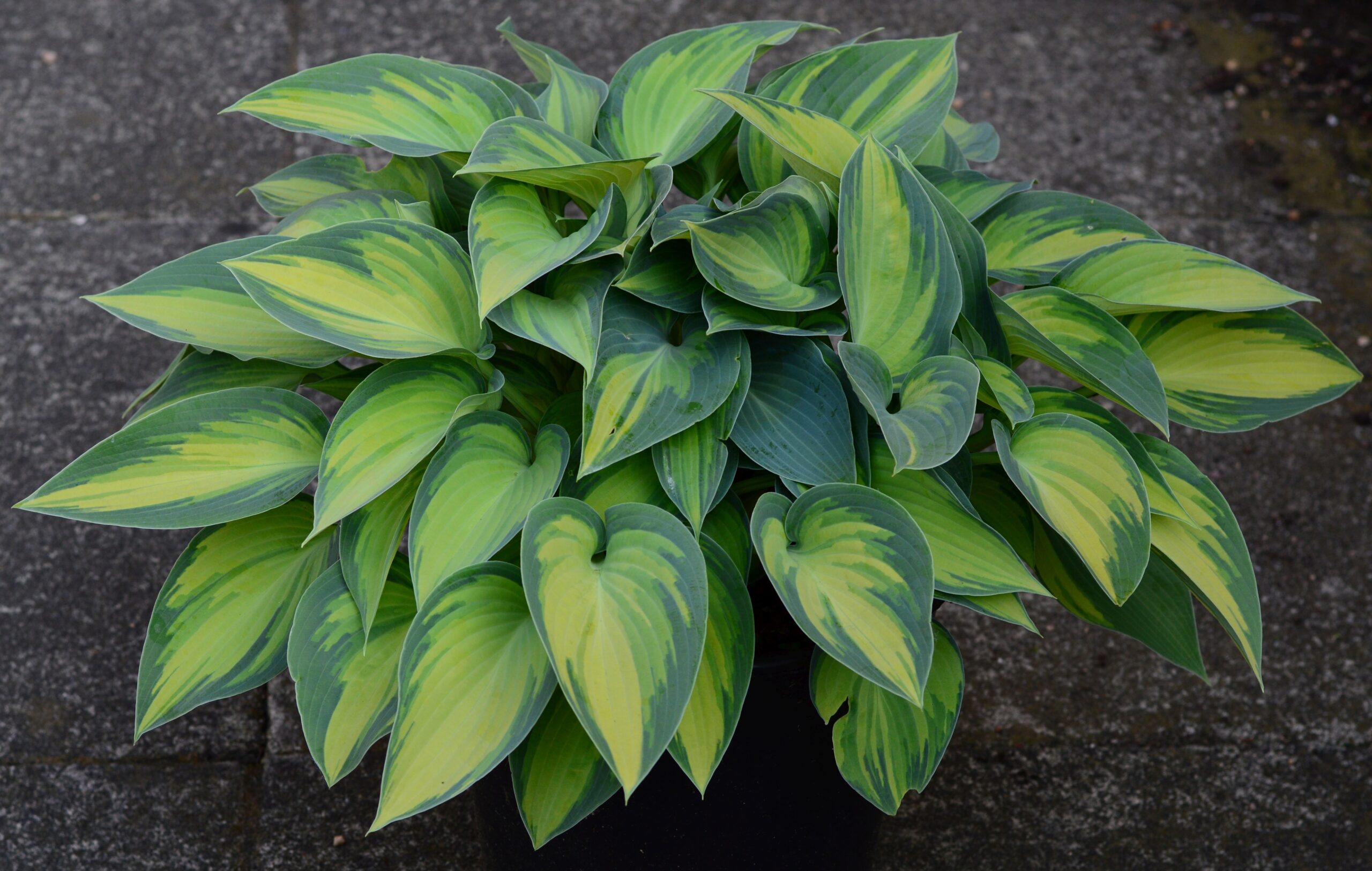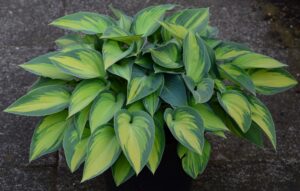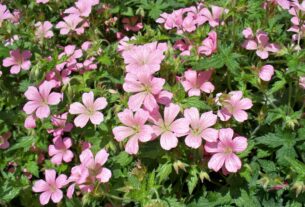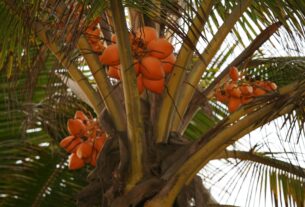Hostas, commonly known as plantain lilies or simply hostas, are a captivating genus of perennial plants renowned for their exceptional foliage and adaptability to shaded garden settings. Belonging to the Asparagaceae family, hostas are celebrated for their diverse range of leaf shapes, sizes, and colors, making them a versatile choice for a variety of garden designs. With over 70 species and countless cultivars, hostas offer a wealth of options for gardeners seeking to add texture, color, and interest to their shaded or partially shaded landscapes.
Native to East Asia, including regions of Japan, China, and Korea, hostas are naturally adapted to forested environments where they thrive in the dappled light beneath taller trees. Their ability to flourish in low-light conditions and their lush, attractive foliage have made them a popular choice for gardeners around the world. Beyond their aesthetic appeal, hostas play a significant ecological role by providing ground cover, supporting local wildlife, and contributing to the overall health of garden ecosystems. Whether used as bold focal points or subtle complements to other shade-loving plants, hostas are a valuable and versatile addition to any garden.
(pxhere.com)
Overview
Botanical Description
Ecological and Cultural Significance
(Ecology)
Hostas are native to East Asia, specifically regions of Japan, China, and Korea. In their natural habitats, hostas thrive in forested environments, growing under the canopy of larger trees and adapting to low-light conditions and often moist, rich soils. They play a crucial role in their native ecosystems by providing ground cover that helps prevent soil erosion and retains soil moisture. The broad, dense foliage of hostas creates a microhabitat for various insects and microorganisms, which are essential components of the forest ecosystem. These insects and microorganisms contribute to the decomposition of organic matter, nutrient cycling, and overall soil health.
In cultivated gardens, hostas continue to support biodiversity. Their ability to establish a thick ground cover creates a habitat for a range of beneficial insects, including pollinators and predatory insects that help control garden pests. Hostas also contribute to the creation of microhabitats for small creatures and microorganisms, enhancing the ecological balance in garden environments. By incorporating hostas into garden designs, gardeners can support local wildlife and contribute to a more sustainable and balanced garden ecosystem.
(Garden Uses)
Hostas are particularly well-suited for shaded or woodland gardens, thanks to their tolerance for low light conditions. They are ideal for brightening up dark corners of gardens or for use under the canopy of trees where other plants might struggle due to insufficient light. Hostas thrive in these challenging conditions, making them valuable for filling in spaces that would otherwise be difficult to plant. In garden design, hostas are commonly used as border plants, in mass plantings, or as specimen plants in containers. Their ability to adapt to various roles allows them to contribute to the creation of lush, textured landscapes that can thrive even in less ideal conditions.
Their versatility makes hostas a valuable asset in garden design, providing both aesthetic appeal and functional benefits. Whether used to create a vibrant border, a lush ground cover, or a striking focal point in containers, hostas help enhance garden spaces with their attractive foliage and adaptability. Their presence can transform shaded areas into visually appealing and functional garden features.
(Companion Plants)
Hostas pair exceptionally well with other shade-loving plants, which enhances their effectiveness in shaded garden areas. They complement ferns, astilbes, and bleeding hearts, all of which share similar light and moisture requirements. The varied textures and colors of these companion plants create a rich, layered look in shaded garden spaces, adding visual interest and diversity. Additionally, hostas can be combined with spring-flowering bulbs such as daffodils and snowdrops, which bloom before the hostas fully emerge in the spring. This combination provides seasonal interest and color contrast, as the early-blooming bulbs offer a splash of brightness that complements the emerging foliage of hostas.
By integrating hostas with a variety of companion plants, gardeners can create dynamic and visually appealing garden designs. The interplay of textures and colors among shade-loving plants enhances the overall aesthetic and functionality of shaded garden areas. Hostas’ ability to work harmoniously with other plants makes them an essential component of well-designed shade gardens.
Varieties and Cultivars
Hostas are renowned for their wide range of sizes, colors, and leaf patterns, making them a versatile choice for diverse garden designs. With numerous varieties and cultivars available, each offers unique characteristics that can enhance different aspects of garden aesthetics. Here are some notable varieties:
(Blue Angel)
The ‘Blue Angel’ cultivar is renowned for its large, heart-shaped leaves that showcase a striking blue-green color. These leaves have a smooth, waxy texture that enhances their luxurious appearance and contributes to the plant’s overall lush and full look. The rounded shape of the leaves adds a soft, elegant touch, making ‘Blue Angel’ a standout feature in garden designs. Its substantial size allows it to create a bold presence in shaded or partially shaded areas, where its vibrant hue can make a significant visual impact.
This variety’s large stature and distinctive coloration make it an ideal choice for adding a dramatic element to garden landscapes. ‘Blue Angel’ thrives in low-light conditions, making it well-suited for spots under trees or in shaded corners where other plants might struggle. Its ability to provide a striking contrast against darker garden elements adds to its appeal, making ‘Blue Angel’ a favored selection for gardeners seeking both beauty and presence in their shade gardens.
(Sum and Substance)
‘Sum and Substance’ is celebrated for its impressive size and bold, golden-yellow foliage. The leaves of this cultivar can grow up to 36 inches in length, making it one of the largest hostas available. Its substantial size and vibrant color make it a commanding presence in any garden landscape, creating a dramatic focal point that is hard to ignore. The bold, golden-yellow hue contrasts beautifully with darker foliage or shaded areas, providing a bright and eye-catching element in garden designs.
This variety’s size and color make it particularly effective in creating a strong visual statement. ‘Sum and Substance’ thrives in shaded environments where its large, striking leaves can fill space and make a significant impact. Its impressive dimensions and vivid color ensure that it stands out in garden settings, making it a top choice for those looking to make a bold and memorable addition to their garden design.
(Patriot)
The ‘Patriot’ variety is known for its distinctive variegated leaves, which feature dark green centers and crisp white margins. This striking color contrast creates a visually appealing effect, adding depth and interest to shaded or woodland gardens. The consistent and uniform variegation of ‘Patriot’ makes it a popular choice for enhancing garden aesthetics with a clean and eye-catching design. The sharp delineation between the dark green and white highlights the plant’s unique visual appeal.
In garden settings, ‘Patriot’ adds a touch of elegance and definition to shaded areas. Its variegated leaves provide a dynamic visual effect, complementing other shade-loving plants and creating a cohesive look in garden designs. The distinctive color pattern of ‘Patriot’ makes it a valuable addition for gardeners looking to introduce a touch of contrast and visual interest to their shaded garden spaces.
(Frances Williams)
‘Frances Williams’ is distinguished by its unique color pattern, featuring green leaves with wide, blue margins and a vibrant chartreuse center. This combination of colors creates a dynamic and eye-catching appearance that adds brightness and contrast to shaded garden areas. The vibrant chartreuse center, paired with the blue margins, creates a visually striking effect that enhances the overall aesthetic of garden spaces.
This cultivar is particularly effective in adding a touch of color and visual interest to shaded areas. The unique color pattern of ‘Frances Williams’ makes it a standout choice for creating focal points and enhancing garden design with its vibrant hues. Its ability to provide contrast and brightness in low-light conditions ensures that ‘Frances Williams’ remains a favorite among gardeners seeking to elevate the visual appeal of their shade gardens.
(El Nino)
The ‘El Nino’ cultivar is noted for its elegant variegated leaves, featuring blue-green centers with crisp white edges. This sophisticated color pattern offers a refined and attractive appearance, creating a striking contrast within garden settings. The combination of blue-green and white provides a sophisticated touch that enhances the visual interest and texture of shaded garden beds.
‘El Nino’ excels at adding a touch of elegance and texture to garden designs. Its distinctive coloration and refined appearance make it a standout choice for creating focal points in shaded areas. The unique color pattern of ‘El Nino’ ensures that it adds a sophisticated element to garden landscapes, making it an appealing option for gardeners looking to enhance their shade gardens with a touch of elegance.
These hosta varieties exemplify the diversity available within the genus, each bringing its own unique beauty and characteristics to garden design. Whether you are looking for a bold statement plant or a subtle complement to other shade-loving species, there is likely a hosta variety to meet your needs.
Care and Maintenance
(Soil)
Hostas thrive best in well-drained, moist soil enriched with organic matter. They prefer loamy soil, which strikes a balance between retaining moisture and allowing excess water to drain away. This type of soil helps ensure that the hostas receive a steady supply of nutrients and maintains a favorable environment for root development. To enhance soil quality, incorporating compost or well-rotted manure can improve both the texture and fertility of the soil, promoting healthy growth and vibrant foliage.
Although hostas favor loamy soil, they are adaptable and can grow in various soil types, provided that good drainage is maintained. Heavy clay soils or overly sandy soils can be amended to improve drainage and nutrient content, making them more suitable for hosta cultivation. Regularly adding organic matter helps maintain soil health and supports the long-term success of hosta plants by providing the necessary nutrients and maintaining an optimal growing environment.
(Watering)
Consistent watering is crucial for the health of hostas, particularly during dry periods. These plants prefer soil that remains consistently moist but not waterlogged. Overwatering can lead to root rot and other issues, while insufficient watering can stress the plants and cause damage to the foliage. To help manage soil moisture, applying a layer of mulch around the base of the hostas is beneficial. Mulch helps retain moisture, regulates soil temperature, and reduces competition from weeds, creating a more stable and favorable environment for the hostas.
Monitoring soil moisture and adjusting watering practices as needed will help keep hostas healthy. During periods of heavy rainfall, ensure that the soil drains well to prevent waterlogging. Conversely, during dry spells, increase watering to maintain consistent moisture levels. This balanced approach to watering will support the overall health and vigor of hostas, ensuring they remain a lush and attractive feature in the garden.
(Fertilization)
Hostas benefit from annual fertilization to support their growth and development. A balanced, general-purpose fertilizer applied in early spring as new growth begins is ideal. Fertilizers with equal proportions of nitrogen, phosphorus, and potassium provide the essential nutrients needed for robust foliage and overall plant health. It’s important to follow the manufacturer’s recommendations for application rates to avoid over-fertilization, which can lead to excessive leaf growth and increased susceptibility to pests and diseases.
Over-fertilizing can also detract from flower production and impact the plant’s overall balance. Regularly monitoring the condition of your hostas and adjusting fertilization practices as needed will help maintain their health and vitality. Proper fertilization supports the plant’s growth while ensuring that it remains resilient against environmental stresses and potential pest issues.
(Pruning and Division)
Pruning hostas involves removing dead or damaged leaves to maintain the plant’s appearance and overall health. This practice helps reduce the risk of disease and keeps the foliage looking tidy. Regularly inspecting and trimming away any problematic leaves will also promote better air circulation around the plant, which is beneficial for preventing fungal infections. Pruning should be done as needed throughout the growing season to keep hostas looking their best.
Division is another important aspect of hosta maintenance, typically performed every 3-5 years. Dividing hostas helps rejuvenate the plants and manage their size, ensuring continued health and vigor. The best time to divide hostas is in early spring before new growth begins or in late summer after the peak of the growing season. Carefully digging up the clump, separating it into smaller sections, and replanting them in prepared soil will help maintain a vibrant and well-managed garden display.
(Pests and Diseases)
Hostas are generally resilient to many pests and diseases, but they can be affected by specific issues. Common pests include slugs and snails, which can damage the leaves by feeding on them. Effective management strategies involve using integrated pest management techniques such as setting up physical barriers, traps, or applying organic control products. These measures help reduce the impact of pests and protect the health of the hostas.
Fungal diseases such as powdery mildew and rust can also affect hostas, particularly in humid conditions. To prevent fungal issues, practice good garden hygiene, including proper spacing for air circulation and avoiding overhead watering. If diseases occur, prompt removal of affected foliage and application of appropriate fungicides can help manage and control the spread. By addressing pest and disease concerns proactively, you can maintain the health and beauty of your hosta plants.
By following these care and maintenance guidelines, hostas can thrive and remain a vibrant and attractive part of the garden for many years. Their adaptability and resilience make them a valuable addition to shaded or partially shaded garden areas.




